Photovoltaic solar cell technologies: analysing the state of the art
The remarkable development in photovoltaic (PV) technologies over the past 5 years calls for a renewed assessment of their performance and potential for future progress. Here, we analyse the progress in cells and modules based on single-crystalline GaAs, Si, GaInP and InP, multicrystalline Si as well as thin films of polycrystalline CdTe and CuInxGa1−xSe2. In addition, we analyse the PV developments of the more recently emerged lead halide perovskites together with notable improvements in sustainable chalcogenides, organic PVs and quantum dots technologies. In addition to power conversion efficiencies, we consider many of the factors that affect power output for each cell type and note improvements in control over the optoelectronic quality of PV-relevant materials and interfaces and the discovery of new material properties. By comparing PV cell parameters across technologies, we appraise how far each technology may progress in the near future. Although accurate or revolutionary developments cannot be predicted, cross-fertilization between technologies often occurs, making achievements in one cell type an indicator of evolutionary developments in others. This knowledge transfer is timely, as the development of metal halide perovskites is helping to unite previously disparate, technology-focused strands of PV research.
This is a preview of subscription content, access via your institution
Access options
Access Nature and 54 other Nature Portfolio journals
Get Nature+, our best-value online-access subscription
cancel any time
Subscribe to this journal
Receive 12 digital issues and online access to articles
133,45 € per year
only 11,12 € per issue
Buy this article
- Purchase on SpringerLink
- Instant access to full article PDF
Prices may be subject to local taxes which are calculated during checkout
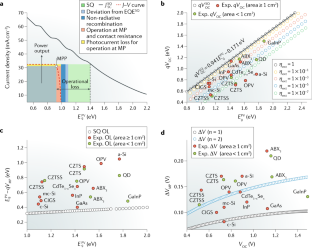

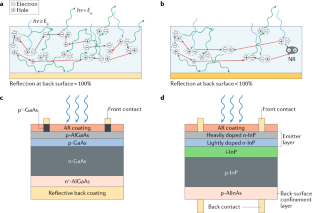
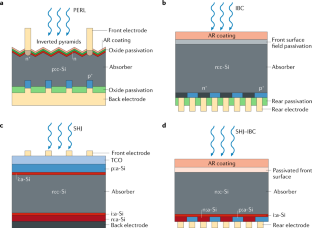
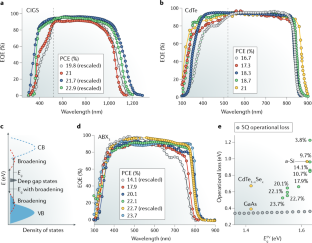

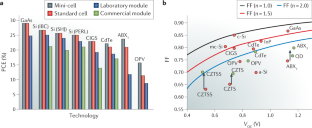
Similar content being viewed by others
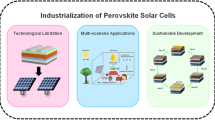
Achievements, challenges, and future prospects for industrialization of perovskite solar cells
Article Open access 03 September 2024
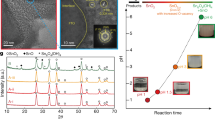
Efficient perovskite solar cells via improved carrier management
Article 24 February 2021
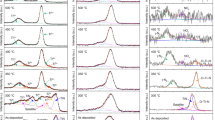
Centimetre-scale perovskite solar cells with fill factors of more than 86 per cent
Article 26 January 2022
References
- Shockley, W. & Queisser, H. J. Detailed balance limit of efficiency of p–n junction solar cells. J. Appl. Phys.32, 510–519 (1961). ArticleCASGoogle Scholar
- Nayak, P. K., Bisquert, J. & Cahen, D. Assessing possibilities and limits for solar cells. Adv. Mater.23, 2870–2876 (2011). This study introduces operational loss as a parameter for the comparison and analysis of solar cell technologies. ArticleCASGoogle Scholar
- Nayak, P. K. & Cahen, D. Updated assessment of possibilities and limits for solar cells. Adv. Mater.26, 1622–1628 (2014). ArticleCASGoogle Scholar
- Rau, U., Blank, B., Müller, T. C. M. & Kirchartz, T. Efficiency potential of photovoltaic materials and devices unveiled by detailed-balance analysis. Phys. Rev. Appl.7, 044016 (2017). This study introduces the concept of determining the photovoltaic gap of a solar cell from the EQE of the cell. ArticleGoogle Scholar
- Wang, Y. et al. Optical gaps of organic solar cells as a reference for comparing voltage losses. Adv. Energy Mater.8, 1801352 (2018). ArticleGoogle Scholar
- Markvart, T. The thermodynamics of optical étendue. J. Opt. A10, 015008 (2008). ArticleGoogle Scholar
- Hirst, L. C. & Ekins-Daukes, N. J. Fundamental losses in solar cells. Prog. Photovolt.19, 286–293 (2011). This article provides analytical expressions for the fundamental losses in solar cells. ArticleGoogle Scholar
- Miller, O. D., Yablonovitch, E. & Kurtz, S. R. Strong internal and external luminescence as solar cells approach the Shockley–Queisser limit. IEEE J. Photovolt.2, 303–311 (2012). ArticleGoogle Scholar
- Rau, U. Reciprocity relation between photovoltaic quantum efficiency and electroluminescent emission of solar cells. Phys. Rev. B76, 085303 (2007). ArticleGoogle Scholar
- Green, M. A. et al. Solar cell efficiency tables (version 53). Prog. Photovolt.27, 3–12 (2019). This article provides solar cell parameters for the state-of-the-art cells. ArticleGoogle Scholar
- Schnitzer, I., Yablonovitch, E., Caneau, C. & Gmitter, T. J. Ultrahigh spontaneous emission quantum efficiency, 99.7% internally and 72% externally, from AlGaAs/GaAs/AlGaAs double heterostructures. Appl. Phys. Lett.62, 131–133 (1993). ArticleCASGoogle Scholar
- Green, M. A. Radiative efficiency of state-of-the-art photovoltaic cells. Prog. Photovolt.20, 472–476 (2012). ArticleCASGoogle Scholar
- Sheng, X. et al. Device architectures for enhanced photon recycling in thin-film multijunction solar cells. Adv. Energy Mater.5, 1400919 (2015). ArticleGoogle Scholar
- Geisz, J. F., Steiner, M. A., García, I., Kurtz, S. R. & Friedman, D. J. Enhanced external radiative efficiency for 20.8% efficient single-junction GaInP solar cells. Appl. Phys. Lett.103, 041118 (2013). ArticleGoogle Scholar
- Steiner, M. A. et al. CuPt ordering in high bandgap GaxIn1-xP alloys on relaxed GaAsP step grades. J. Appl. Phys.106, 063525 (2009). ArticleGoogle Scholar
- Green, M. A. et al. Solar cell efficiency tables (version 49). Prog. Photovolt.25, 3–13 (2017). ArticleGoogle Scholar
- Wanlass, M. Systems and methods for advanced ultra-high-performance InP solar cells. US Patent US9590131B2 (2014).
- Green, M. A., Emery, K., Hishikawa, Y., Warta, W. & Dunlop, E. D. Solar cell efficiency tables (version 42). Prog. Photovolt.21, 827–837 (2013). ArticleGoogle Scholar
- Yoshikawa, K. et al. Silicon heterojunction solar cell with interdigitated back contacts for a photoconversion efficiency over 26%. Nat. Energy2, 17032 (2017). This study presents an efficient (PCE = 26.6%) c-Si solar cell with the IBC–SHJ architecture. ArticleCASGoogle Scholar
- Green, M. A. et al. Solar cell efficiency tables (version 52). Prog. Photovolt.26, 427–436 (2018). ArticleGoogle Scholar
- Taguchi, M. et al. 24.7% record efficiency HIT solar cell on thin silicon wafer. IEEE J. Photovolt.4, 96–99 (2014). ArticleGoogle Scholar
- Richter, A., Hermle, M. & Glunz, S. W. Reassessment of the limiting efficiency for crystalline silicon solar cells. IEEE J. Photovolt.3, 1184–1191 (2013). ArticleGoogle Scholar
- Trupke, T., Zhao, J., Wang, A., Corkish, R. & Green, M. A. Very efficient light emission from bulk crystalline silicon. Appl. Phys. Lett.82, 2996–44107 (2003). ArticleCASGoogle Scholar
- Yang, Y. M. et al. Development of high-performance multicrystalline silicon for photovoltaic industry. Prog. Photovolt.23, 340–351 (2015). ArticleCASGoogle Scholar
- Macdonald, D. & Geerligs, L. J. Recombination activity of interstitial iron and other transition metal point defects in p- and n-type crystalline silicon. Appl. Phys. Lett.85, 4061–4063 (2004). ArticleCASGoogle Scholar
- Benick, J. et al. High-efficiency n-type HP mc silicon solar cells. IEEE J. Photovolt.7, 1171–1175 (2017). ArticleGoogle Scholar
- Chirilă, A. et al. Potassium-induced surface modification of Cu(In,Ga)Se2 thin films for high-efficiency solar cells. Nat. Mater.12, 1107–1111 (2013). ArticleGoogle Scholar
- Chantana, J., Kato, T., Sugimoto, H. & Minemoto, T. Thin-film Cu(In,Ga)(Se,S)2-based solar cell with (Cd,Zn)S buffer layer and Zn1−xMgxO window layer. Prog. Photovolt.25, 431–440 (2017). ArticleCASGoogle Scholar
- Kato, T., Wu, J.-L., Hirai, Y., Sugimoto, H. & Bermudez, V. Record efficiency for thin-film polycrystalline solar cells up to 22.9% achieved by Cs-treated Cu(In,Ga)(Se,S)2. IEEE J. Photovolt.9, 325–330 (2018). ArticleGoogle Scholar
- IEEE Electron Devices Society. IEEE Electron Devices Society Newsletter: highlights of the 2017 IEEE Photovoltaic Specialists Conference. IEEEhttps://eds.ieee.org/images/files/newsletters/newsletter_oct17.pdf (2017).
- Poplawsky, J. D. et al. Structural and compositional dependence of the CdTexSe1−x alloy layer photoactivity in CdTe-based solar cells. Nat. Commun.7, 12537 (2016). ArticleCASGoogle Scholar
- Paudel, N. R., Poplawsky, J. D., Moore, K. L. & Yan, Y. Current enhancement of CdTe-based solar cells. IEEE J. Photovolt.5, 1492–1496 (2015). ArticleGoogle Scholar
- Zhao, Y. et al. Monocrystalline CdTe solar cells with open-circuit voltage over 1 V and efficiency of 17%. Nat. Energy1, 16067 (2016). ArticleCASGoogle Scholar
- Gloeckler, M., Sankin, I. & Zhao, Z. CdTe solar cells at the threshold to 20% efficiency. IEEE J. Photovolt.3, 1389–1393 (2013). ArticleGoogle Scholar
- Lokanc, M., Eggert, R. & Redlinger, M. The availability of indium: the present, medium term, and long term. NRELhttps://www.nrel.gov/docs/fy16osti/62409.pdf (2015).
- Gokmen, T., Gunawan, O., Todorov, T. K. & Mitzi, D. B. Band tailing and efficiency limitation in kesterite solar cells. Appl. Phys. Lett.103, 103506 (2013). ArticleGoogle Scholar
- Ng, T. M. et al. Optoelectronic and spectroscopic characterization of vapour-transport grown Cu2ZnSnS4 single crystals. J. Mater. Chem. A5, 1192–1200 (2017). ArticleCASGoogle Scholar
- Yan, C. et al. Beyond 11% efficient sulfide kesterite Cu2ZnxCd1−xSnS4 solar cell: effects of cadmium alloying. ACS Energy Lett.2, 930–936 (2017). ArticleCASGoogle Scholar
- Kronik, L., Cahen, D. & Schock, H. W. Effects of sodium on polycrystalline Cu(In, Ga)Se2 and its solar cell performance. Adv. Mater.10, 31–36 (1998). ArticleCASGoogle Scholar
- Nayak, P. K., Garcia-Belmonte, G., Kahn, A., Bisquert, J. & Cahen, D. Photovoltaic efficiency limits and material disorder. Energy Environ. Sci.5, 6022 (2012). ArticleCASGoogle Scholar
- Kim, S., Park, J. S. & Walsh, A. Identification of killer defects in kesterite thin-film solar cells. ACS Energy Lett.3, 496–500 (2018). ArticleCASGoogle Scholar
- Snaith, H. J. Present status and future prospects of perovskite photovoltaics. Nat. Mater.17, 372–376 (2018). This is a recent review on halide perovskite materials for optoelectronic applications. ArticleCASGoogle Scholar
- Stranks, S. D. et al. Electron-hole diffusion lengths exceeding 1 micrometer in an organometal trihalide perovskite absorber. Science342, 341–344 (2013). ArticleCASGoogle Scholar
- Edri, E. et al. Elucidating the charge carrier separation and working mechanism of CH3NH3PbI3−xClx perovskite solar cells. Nat. Commun.5, 3461 (2014). ArticleGoogle Scholar
- Ceratti, D. R. et al. Self-healing inside APbBr3 halide perovskite crystals. Adv. Mater.30, 1706273 (2018). ArticleGoogle Scholar
- Brandt, R. E., Stevanovic, V., Ginley, D. S. & Buonassisi, T. Identifying defect-tolerant semiconductors with high minority-carrier lifetimes: beyond hybrid lead halide perovskites. MRS Commun.5, 265–275 (2015). ArticleCASGoogle Scholar
- Zakutayev, A. et al. Defect tolerant semiconductors for solar energy conversion. J. Phys. Chem. Lett.5, 1117–1125 (2014). ArticleCASGoogle Scholar
- De Wolf, S. et al. Organometallic halide perovskites: sharp optical absorption edge and its relation to photovoltaic performance. J. Phys. Chem. Lett.5, 1035–1039 (2014). ArticleGoogle Scholar
- Sutter-Fella, C. M. et al. Band tailing and deep defect states in CH3NH3Pb(I1−xBrx)3 perovskites as revealed by sub-bandgap photocurrent. ACS Energy Lett.2, 709–715 (2017). ArticleCASGoogle Scholar
- Braly, I. L. et al. Hybrid perovskite films approaching the radiative limit with over 90% photoluminescence quantum efficiency. Nat. Photonics12, 355–361 (2018). ArticleCASGoogle Scholar
- Tiedje, T. Band tail recombination limit to the output voltage of amorphous silicon solar cells. Appl. Phys. Lett.40, 627–629 (1982). This article demonstrates the effect of tail states on the efficiency of solar cells. ArticleCASGoogle Scholar
- Liu, M. et al. Hybrid organic–inorganic inks flatten the energy landscape in colloidal quantum dot solids. Nat. Mater.16, 258–263 (2017). ArticleCASGoogle Scholar
- Swarnkar, A. et al. Quantum dot-induced phase stabilization of α-CsPbI3 perovskite for high-efficiency photovoltaics. Science354, 92–95 (2016). ArticleCASGoogle Scholar
- Sanehira, E. M. et al. Enhanced mobility CsPbI3 quantum dot arrays for record-efficiency, high-voltage photovoltaic cells. Sci. Adv.3, eaao4204 (2017). ArticleGoogle Scholar
- Mori, S. et al. Organic photovoltaic module development with inverted device structure. Mater. Res. Soc. Symp. Proc.1737, 26–31 (2015). ArticleGoogle Scholar
- Yan, C. et al. Non-fullerene acceptors for organic solar cells. Nat. Rev. Mater.3, 18003 (2018). ArticleCASGoogle Scholar
- Marcus, R. A. Electron transfer reactions in chemistry. Theory and experiment. Rev. Mod. Phys.65, 599–610 (1993). ArticleCASGoogle Scholar
- Benduhn, J. et al. Intrinsic non-radiative voltage losses in fullerene-based organic solar cells. Nat. Energy2, 17053 (2017). ArticleCASGoogle Scholar
- Nayak, P. K. et al. The effect of structural order on solar cell parameters, as illustrated in a SiC-organic junction model. Energy Environ. Sci.6, 3272 (2013). ArticleCASGoogle Scholar
- Qian, D. et al. Design rules for minimizing voltage losses in high-efficiency organic solar cells. Nat. Mater.17, 703–709 (2018). ArticleCASGoogle Scholar
- Chen, X. K. & Brédas, J. L. Voltage losses in organic solar cells: understanding the contributions of intramolecular vibrations to nonradiative recombinations. Adv. Energy Mater.8, 1702227 (2018). ArticleGoogle Scholar
- Jean, J. et al. Radiative efficiency limit with band tailing exceeds 30% for quantum dot solar cells. ACS Energy Lett.2, 2616–2624 (2017). ArticleCASGoogle Scholar
- Venkateshvaran, D. et al. Approaching disorder-free transport in high-mobility conjugated polymers. Nature515, 384–388 (2014). ArticleCASGoogle Scholar
- Green, M. A. Accuracy of analytical expressions for solar cell fill factors. Solar Cells7, 337–340 (1982). ArticleCASGoogle Scholar
- Oxford PV. Oxford PV perovskite solar cell achieves 28% efficiency. Oxford PVhttps://www.oxfordpv.com/news/oxford-pv-perovskite-solar-cell-achieves-28-efficiency (2018).
- Haxel, G. B., Hedrick, J. B. & Orris, G. J. Rare earth elements: critical resources for high technology: US Geological Survey fact sheet 087–02. USGShttps://pubs.usgs.gov/fs/2002/fs087-02/ (updated 17 May 2005).
- Chuangchote, S. et al. Review of environmental, health and safety of CdTe photovoltaic installations throughout their life-cycle. First Solarhttp://www.firstsolar.com/-/media/First-Solar/Sustainability-Documents/Sustainability-Peer-Reviews/Thai-EHS-Peer-Review_EN.ashx (2012).
- CHEOPS. First results regarding the environmental impact of perovskite/silicon tandem PV modules. CHEOPShttps://www.cheops-project.eu/news-in-brief/first-results-regarding-the-environmental-impact-of-perovskitesilicon-tandem-pv-modules (2017).
- Meng, L. et al. Organic and solution-processed tandem solar cells with 17.3% efficiency. Science361, eaat2612 (2018). ArticleGoogle Scholar
- Ekins-Daukes, N. J. & Hirst, L. C. in 24th European Photovoltaic Solar Energy Conf. 457–461 (WIP-Munich, 2009).
- Green, M. A., Emery, K., Hishikawa, Y., Warta, W. & Dunlop, E. D. Solar cell efficiency tables (version 40). Prog. Photovolt.20, 606–614 (2012). ArticleGoogle Scholar
- Green, M. A., Emery, K., Hishikawa, Y., Warta, W. & Dunlop, E. D. Solar cell efficiency tables (version 47). Prog. Photovolt.24, 3–11 (2016). ArticleGoogle Scholar
- Adachi, D., Hernández, J. L. & Yamamoto, K. Impact of carrier recombination on fill factor for large area heterojunction crystalline silicon solar cell with 25.1% efficiency. Appl. Phys. Lett.107, 233506 (2015). ArticleGoogle Scholar
- Green, M. A. et al. Solar cell efficiency tables (version 50). Prog. Photovolt.25, 668–676 (2017). ArticleGoogle Scholar
- Kojima, A., Teshima, K., Shirai, Y. & Miyasaka, T. Organometal halide perovskites as visible-light sensitizers for photovoltaic cells. J. Am. Chem. Soc.131, 6050–6051 (2009). ArticleCASGoogle Scholar
- Kim, H.-S. et al. Lead iodide perovskite sensitized all-solid-state submicron thin film mesoscopic solar cell with efficiency exceeding 9%. Sci. Rep.2, 591 (2012). ArticleGoogle Scholar
- Lee, M. M., Teuscher, J., Miyasaka, T., Murakami, T. N. & Snaith, H. J. Efficient hybrid solar cells based on meso-superstructured organometal halide perovskites. Science338, 643–647 (2012). ArticleCASGoogle Scholar
- Gong, W. et al. Influence of energetic disorder on electroluminescence emission in polymer: fullerene solar cells. Phys. Rev. B86, 024201 (2012). ArticleGoogle Scholar
- Liu, J. et al. Fast charge separation in a non-fullerene organic solar cell with a small driving force. Nat. Energy1, 16089 (2016). ArticleCASGoogle Scholar
- Green, M. A., Emery, K., Hishikawa, Y., Warta, W. & Dunlop, E. D. Solar cell efficiency tables (version 44). Prog. Photovolt.22, 701–710 (2014). ArticleGoogle Scholar
- Green, M. A. et al. Solar cell efficiency tables (version 51). Prog. Photovolt.26, 3–12 (2018). ArticleGoogle Scholar
- Green, M. A., Emery, K., Hishikawa, Y., Warta, W. & Dunlop, E. D. Solar cell efficiency tables (Version 45). Prog. Photovolt.23, 1–9 (2015). ArticleGoogle Scholar
Acknowledgements
The authors acknowledge the support from the UK Engineering and Physical Sciences Research Council (grant nos EP/P032591/1 and EP/M015254/2) and thank B. Wenger, T. Markvardt, T. Kirchartz, T. Buonassisi and A. Bakulin for critical comments and data and D. Friedman for providing a GaAs cell. D.C. thanks the Weizmann Institute of Science, where he held the Rowland and Sylvia Schaefer Chair in Energy Research, for partial support.
Author information
Authors and Affiliations
- Clarendon Laboratory, Department of Physics, University of Oxford, Oxford, UK Pabitra K. Nayak, Suhas Mahesh & Henry J. Snaith
- Department of Materials and Interfaces, Weizmann Institute of Science, Rehovot, Israel David Cahen
- Pabitra K. Nayak











